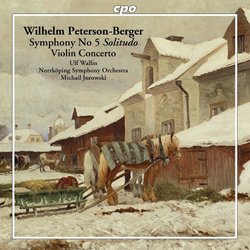| All Artists: Wilhelm Peterson-Berger, Michail Jurowski, Norrköping Symphony Orchestra Title: Wilhelm Peterson-Berger: Symphony No. 5 "Solitudo"; Violin Concerto Members Wishing: 1 Total Copies: 0 Label: Cpo Records Original Release Date: 1/1/2005 Re-Release Date: 8/16/2005 Genre: Classical Styles: Forms & Genres, Concertos, Instruments, Strings, Symphonies Number of Discs: 1 SwapaCD Credits: 1 UPC: 761203998425 |
Search - Wilhelm Peterson-Berger, Michail Jurowski, Norrköping Symphony Orchestra :: Wilhelm Peterson-Berger: Symphony No. 5 "Solitudo"; Violin Concerto
 | Wilhelm Peterson-Berger, Michail Jurowski, Norrköping Symphony Orchestra Wilhelm Peterson-Berger: Symphony No. 5 "Solitudo"; Violin Concerto Genre: Classical |
Larger Image |
CD Details |
CD ReviewsA Tuneful, Conservative, Well-Crafted Symphony; A Marvelous J Scott Morrison | Middlebury VT, USA | 08/20/2005 (4 out of 5 stars) "Although Amazon doesn't yet indicate this in their listing, this CD contains not only the Fifth Symphony of Wilhelm Peterson-Berger, but also his marvelous violin concerto. The latter really is quite wonderful, about which more below.
Peterson-Berger (1867-1942) was known primarily in his day as a stern music critic and as such he made enemies in his native Sweden and elsewhere. (Conductor Armas Järnefelt actually sued him because of a caustic review.) Consequently his own compositions were castigated or ignored during much of his lifetime. Nonetheless, he was a talented and skilled composer. The Fifth Symphony (his last) was written in 1932-33 and is subtitled 'Solitudo.' There is little about it that conjures up solitude, as far as I can hear, but it is a tuneful, well-constructed, ultra-conservative four-movement work that has Wagnerian elements (of the non-neurotic sort, rather more like Humperdinck than Wagner) and Grieg. The booklet notes comment rather extensively on the use of the pentatonic scale in the Violin Concerto, but it is also used frequently in the Symphony as well. Indeed there are some passages that sound Asian and others that sound rather like Native American (Indian) music with a throbbing 4/4 bass. These traits are not at all obtrusive, but hard to ignore once noticed, and although I hadn't been particularly aware of it before, a check of a couple of his earlier symphonies shows some of the same traits. Consequently, the booklet writer's (and contemporary critics') notion that he was in the thrall of Puccini's 'Turandot' (which makes similar use of pentatonicism) strikes me as ill-informed. Peterson-Berger's language also contains clear construction, memorable melodies and rhythms, and unobtrusive but masterful counterpoint. The third movement is a glorious song-inspired rhapsody, the finale a spirited tarantella. Structural seams are occasionally noticeable but not bothersome. A good regional orchestra, the Norköpping Symphony, does a fine job of playing both works under the direction of Michail Jurowski, himself from the middle generation of a quite musical Russian family -- his father was composer Wladimir Jurowski, his son the up-and-coming conductor Vladimir Jurowski who is making quite a name for himself in London and elsewhere. The Violin Concerto is, in my view, a more successful piece than the symphony. It reminds one, in its language, of a mix of Wagnerian and Brahmsian gestures, rather like that of Max Bruch. It is densely melodic, has some interesting structural features (e.g., the use of a quite extended cadenza as most of the development of the first movement) and is entirely winning. I could easily see this concerto becoming, with the right sort of advocacy, a repertoire piece. I would love to hear that several touring violin virtuosi and adventuresome conductors have taken it up. In the usual three movements, it, like the symphony, makes use of Swedish folksong contours without, as far as I know, directly quoting any of them. The finale in particular uses this altogether charming procedure. In the final analysis, Peterson-Berger's music is probably not ever destined for music's A List, but it certainly deserves more attention than it has had and the cpo label is to be given credit for issuing a number of recordings, including, as of now, all the symphonies. Warmly recommended. Scott Morrison" |
